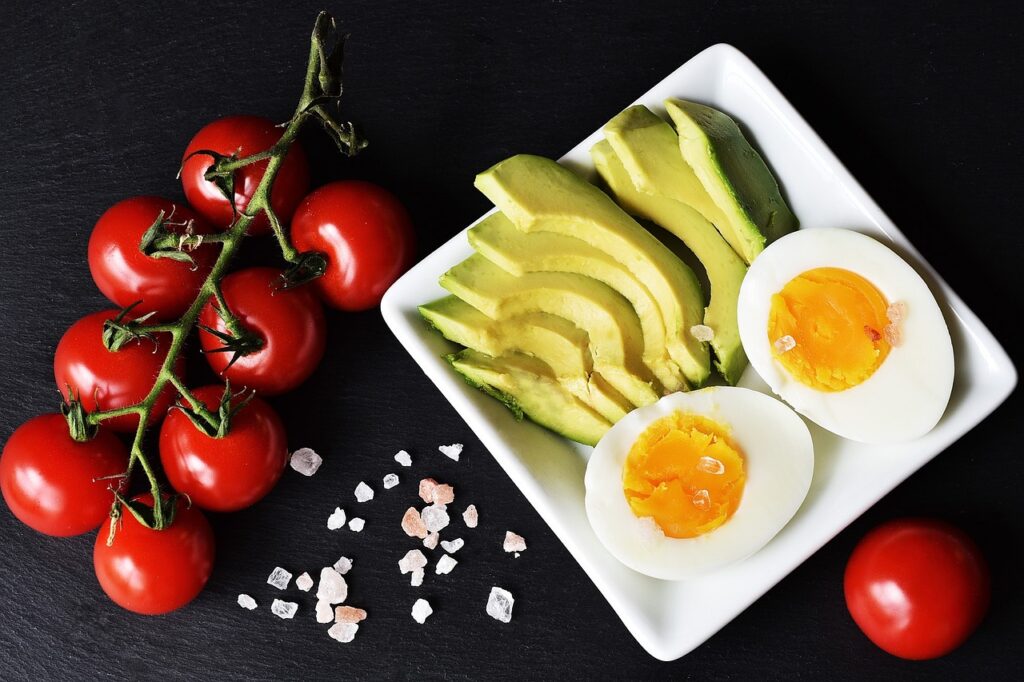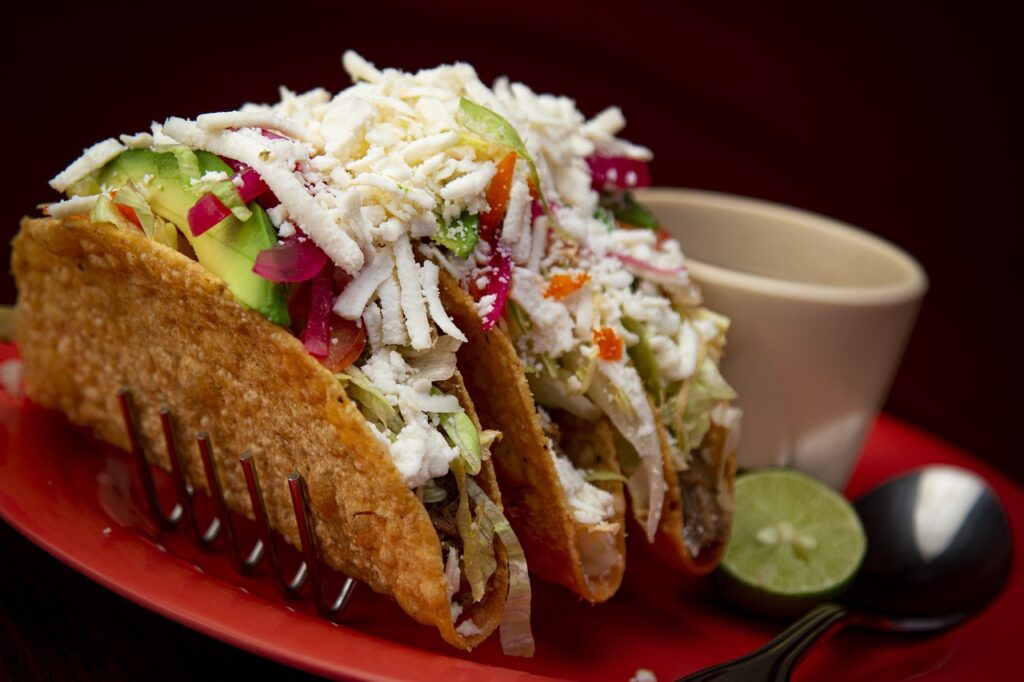Looking to cut carbs and follow a vegetarian keto diet? Wondering what alternatives you have for pasta? Well, look no further because we've got you covered with a list of the top vegetarian keto pasta substitutes.
Whether you're craving a bowl of spaghetti or a plate of lasagna, these options will satisfy your pasta cravings without derailing your diet.
So, what are these magical substitutes? Stay tuned to find out!
Zucchini Noodles
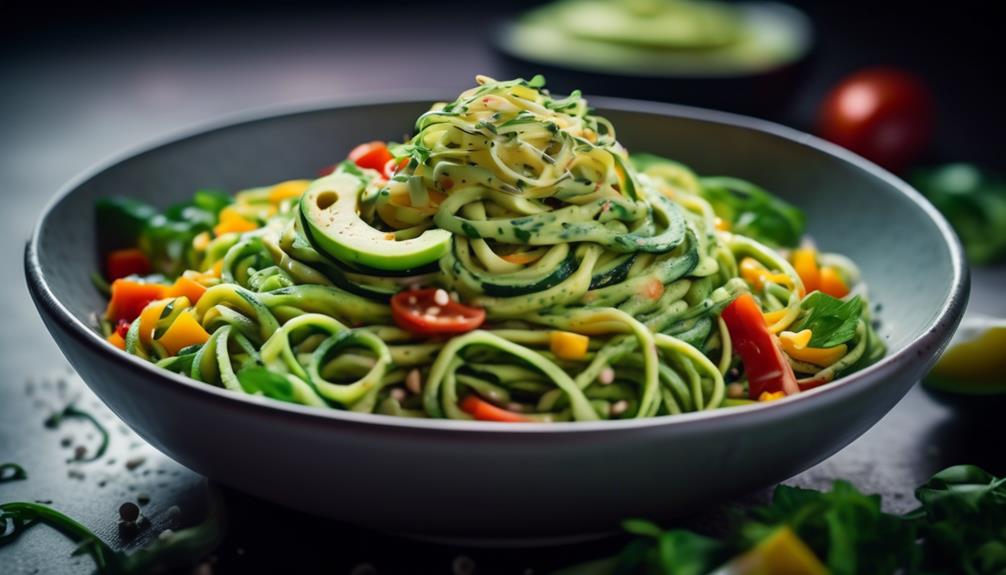
If you're following a vegetarian keto diet and looking for a low-carb pasta substitute, zucchini noodles are a nutritious and versatile option. Zucchini, also known as courgette, is a summer squash that's rich in nutrients and low in carbs. It's an excellent source of vitamins A and C, as well as potassium and dietary fiber. By spiralizing zucchini into thin, noodle-like strands, you can enjoy a satisfying pasta-like dish without the excess carbs.
Zucchini noodles can be used in a variety of recipes, making them a great addition to your vegetarian keto repertoire. One popular way to enjoy zucchini noodles is by tossing them with homemade pesto sauce and adding cherry tomatoes and fresh basil for a refreshing and light meal. Another option is to stir-fry zucchini noodles with your favorite low-carb vegetables and a protein source like tofu or tempeh. This creates a filling and nutritious dish that's packed with flavor.
Aside from being low in carbs and high in nutrients, zucchini noodles also offer several health benefits. They're a good source of antioxidants, which help protect against cellular damage and reduce inflammation in the body. Additionally, zucchini is known for its high water content, which can aid in hydration and promote healthy digestion.
Spaghetti Squash
Spaghetti squash is a versatile and nutritious vegetable that can be used as a satisfying pasta substitute on a vegetarian keto diet. It's low in carbs and calories, making it an ideal option for those following a keto lifestyle. In addition to being a great pasta alternative, spaghetti squash also offers several health benefits.
Here are three reasons why you should consider incorporating spaghetti squash into your vegetarian keto diet:
- Low in Carbs: Spaghetti squash is a low-carb vegetable, making it a suitable choice for those on a keto diet. It contains only 7 grams of net carbs per cup, compared to traditional pasta, which can have upwards of 40 grams of carbs per cup.
- High in Fiber: Spaghetti squash is an excellent source of dietary fiber. One cup of cooked spaghetti squash contains around 2.2 grams of fiber. Consuming adequate fiber is essential for maintaining digestive health and promoting feelings of fullness.
- Rich in Vitamins and Minerals: Spaghetti squash is packed with essential nutrients, including vitamins A, C, and B6, as well as potassium and manganese. These nutrients play a vital role in supporting overall health and well-being.
Incorporating spaghetti squash into your vegetarian keto diet can provide a satisfying pasta substitute while offering numerous health benefits. Try experimenting with different spaghetti squash recipes to find your favorite way to enjoy this nutritious vegetable.
Shirataki Noodles
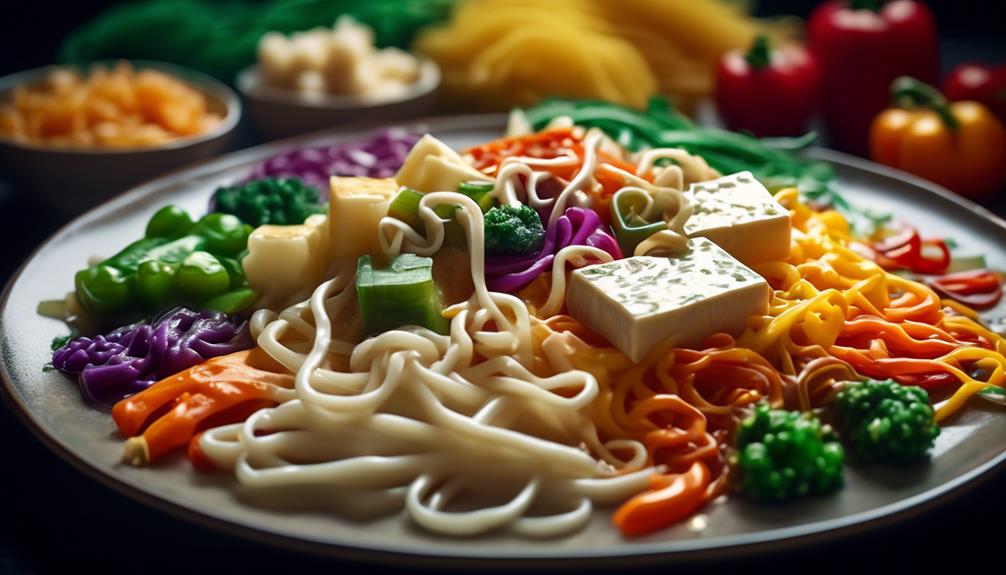
Shirataki noodles are a fantastic low-carb alternative to traditional pasta. Made from the konjac plant, they're virtually carb-free and can be a great option for those following a keto diet.
These noodles are also incredibly easy to prepare and can be used in a variety of recipes, from stir-fries to soups, making them a versatile addition to your vegetarian keto meal plan.
Low-Carb Alternative
For a low-carb alternative to traditional pasta, consider incorporating a highly versatile ingredient that can easily adapt to various culinary creations.
Shirataki noodles, also known as konjac noodles, are a popular choice for those seeking low carb pasta options or keto-friendly noodle alternatives. Here are three reasons why you should give them a try:
- Low in carbs: Shirataki noodles are made from konjac flour, which is virtually carb-free. This makes them an excellent choice for individuals following a low-carb or ketogenic diet.
- High in fiber: These noodles are rich in fiber, which can help promote feelings of fullness and aid in digestion. This can be beneficial for weight management and overall gut health.
- Easy to prepare: Shirataki noodles come pre-cooked and packaged in water. Simply drain and rinse them before incorporating them into your favorite pasta dishes. They've a slightly different texture than traditional pasta but can easily absorb the flavors of your chosen sauce or seasoning.
Incorporating shirataki noodles into your meals can be a simple and delicious way to enjoy pasta dishes while maintaining a low-carb or keto-friendly diet.
Easy to Prepare
If you're looking for a convenient and hassle-free way to prepare shirataki noodles, incorporating them into your favorite pasta dishes is a breeze. These low-carb, high-fiber noodles are an excellent pasta substitute for those following a vegetarian keto diet.
To make it even easier, there are plenty of easy pasta recipes that feature shirataki noodles as the star ingredient. One popular option is to toss the noodles with a simple garlic and olive oil sauce, topped with grated Parmesan cheese and fresh herbs.
Another quick pasta substitute is to use shirataki noodles in a stir-fry with your favorite vegetables and a flavorful sauce.
The possibilities are endless when it comes to creating delicious and satisfying meals with shirataki noodles as your go-to pasta substitute.
Versatile in Recipes
To add a versatile twist to your recipes, shirataki noodles can be seamlessly incorporated into a wide range of dishes. These versatile pasta alternatives aren't only low in carbs and calories, but they also provide a great texture that can mimic traditional pasta.
Here are three ways you can enjoy shirataki noodles in your recipes:
- Stir-fry: Toss the shirataki noodles in a hot pan with your favorite vegetables, protein, and sauce for a quick and delicious stir-fry.
- Soup: Add shirataki noodles to your favorite soup for a hearty and filling meal. They absorb the flavors of the broth and provide a satisfying chew.
- Pasta substitute: Use shirataki noodles as a replacement for traditional pasta in dishes like spaghetti or fettuccine. Pair them with your favorite sauce and toppings for a guilt-free pasta experience.
With these cooking methods for cauliflower rice, you can enjoy a variety of dishes while still sticking to your vegetarian keto diet.
Cauliflower Rice
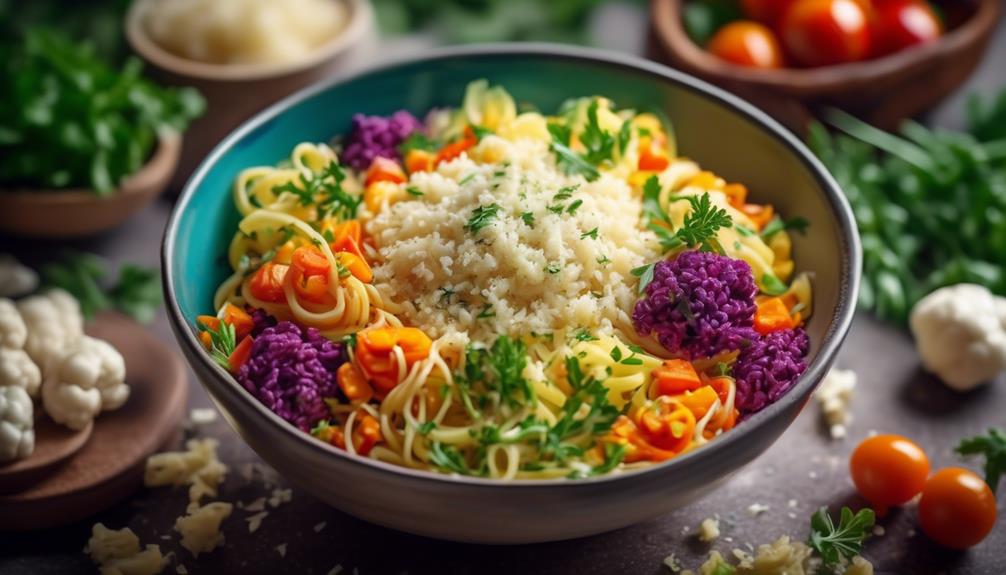
Cauliflower rice is a versatile and nutritious alternative to traditional pasta on a vegetarian keto diet. It's low in carbohydrates and high in fiber, making it a great option for those looking to reduce their carb intake.
Cooking methods for cauliflower rice include steaming, sautéing, and roasting, allowing you to customize the texture and flavor to your liking.
Nutritional Benefits of Cauliflower
With its impressive nutritional profile, cauliflower rice offers a versatile and healthy alternative to traditional pasta dishes. Here are some key reasons why you should consider incorporating cauliflower rice into your diet:
- Low in calories: Cauliflower rice is incredibly low in calories, making it an ideal choice for those looking to manage their weight or reduce calorie intake.
- High in fiber: This cruciferous vegetable is packed with fiber, which can help promote healthy digestion and keep you feeling full for longer periods.
- Nutrient-rich: Cauliflower is rich in essential vitamins and minerals, including vitamin C, vitamin K, and folate. These nutrients play a crucial role in supporting overall health and well-being.
To enjoy the nutritional benefits of cauliflower rice, you can experiment with different cooking techniques such as stir-frying, roasting, or steaming. Incorporating this versatile vegetable into your meals can be a simple and delicious way to enhance both your health and your taste buds.
Cooking Methods for Cauliflower Rice
If you're looking to explore the various ways to cook cauliflower rice, there are several methods that can help you achieve a delicious and nutritious outcome.
One popular cooking technique for cauliflower rice is sautéing. Heat some oil in a pan, add the cauliflower rice, and cook it until it becomes tender and slightly browned.
Another option is steaming, which helps retain the cauliflower's natural flavors and nutrients. Simply place the cauliflower rice in a steamer basket over boiling water and cook until it's soft but still slightly firm.
You can also try roasting cauliflower rice in the oven. Toss it with some oil and seasonings, spread it on a baking sheet, and bake until it's golden brown and crispy.
As for flavoring options, you can add spices like garlic powder, onion powder, or paprika, or even mix in some herbs like parsley or cilantro. Get creative and experiment with different seasonings to find your favorite combination.
Konjac Noodles
Konjac noodles, also known as shirataki noodles, are a versatile and low-carb pasta substitute that can be a great addition to your vegetarian keto diet. These noodles are made from the konjac plant, which is native to Asia and is rich in a dietary fiber called glucomannan.
Here are three reasons why you should consider incorporating konjac noodles into your cooking:
- Low in carbs: Konjac noodles are extremely low in carbohydrates, making them an excellent option for those following a ketogenic diet. In fact, a single serving of konjac noodles contains only a few grams of carbs, making them a perfect choice for maintaining ketosis.
- High in fiber: Glucomannan, the fiber found in konjac noodles, is known for its ability to absorb water and expand in the stomach. This can help promote feelings of fullness and aid in weight loss. Additionally, consuming an adequate amount of fiber is essential for maintaining good digestive health.
- Easy to cook: Cooking konjac noodles is quick and easy. Simply rinse the noodles under cold water, then boil them for 2-3 minutes to remove any odor. After that, you can stir-fry them with your favorite vegetables and sauces or use them as a base for soups and stews.
Incorporating konjac noodles into your vegetarian keto diet can provide you with a delicious and satisfying pasta alternative while keeping your carb intake in check. Enjoy the benefits of these low-carb noodles and explore various recipes to diversify your meals.
Eggplant Lasagna Sheets
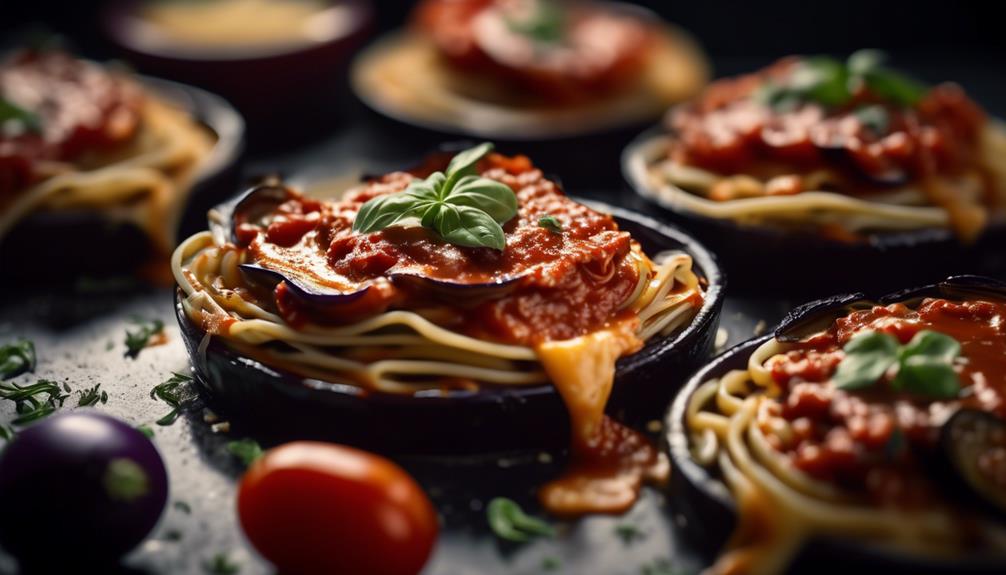
If you're following a vegetarian keto diet and looking for a pasta substitute, eggplant lasagna sheets are a great option. Not only are they low in carbs, but eggplants also offer several health benefits. They're rich in fiber, vitamin C, and antioxidants, which can support your overall well-being.
To prepare eggplant lasagna sheets, slice the eggplant lengthwise and roast or grill them until tender.
Eggplant Benefits for Keto
Eggplant, with its versatile and low-carb nature, serves as an excellent substitute for traditional pasta sheets in a keto-friendly lasagna. Not only does it provide a satisfying texture, but it also offers numerous health benefits that make it a smart choice for those following a keto diet.
Here are three reasons why you should consider using eggplant lasagna sheets in your next meal:
- Low in carbs: Eggplant contains only 6 grams of carbs per cup, making it an ideal choice for those watching their carbohydrate intake on a keto diet.
- Rich in nutrients: Eggplants are a good source of vitamins, minerals, and antioxidants, including vitamins C and K, potassium, and anthocyanins, which have been linked to various health benefits.
- High in fiber: With 2.5 grams of fiber per cup, eggplants can help promote digestion and keep you feeling full and satisfied.
How to Prepare Eggplant
To prepare eggplant for use as lasagna sheets in your keto-friendly meal, follow these simple steps.
- Start by preheating your oven to 400°F (200°C).
- Next, wash the eggplant and cut off both ends.
- Using a sharp knife, slice the eggplant lengthwise into thin, even sheets.
- Sprinkle salt on both sides of the eggplant slices and let them sit for about 15 minutes. This will help draw out excess moisture and bitterness.
- After 15 minutes, rinse the eggplant slices under cold water and pat them dry with a paper towel.
- Place the slices on a baking sheet lined with parchment paper and brush them lightly with olive oil.
- Bake for about 10-12 minutes or until the slices are tender and slightly golden.
Your eggplant lasagna sheets are now ready to be used in various delicious eggplant recipes and keto-friendly eggplant dishes. Enjoy!
Cabbage Leaves
Cabbage leaves can be a versatile and nutritious alternative to traditional pasta in vegetarian keto dishes. They offer a low-carb option that's packed with fiber, vitamins, and minerals.
Here are three ways you can enjoy cabbage leaves in your vegetarian keto meals:
- Cabbage Rolls: Cabbage leaves make the perfect wrap for delicious and filling cabbage rolls. Simply blanch the leaves to make them pliable, then fill them with your choice of ingredients like mushrooms, tofu, or cauliflower rice. Bake them in a tomato sauce for a satisfying meal that's both keto-friendly and packed with flavor.
- Stuffed Cabbage Recipes: Another great way to use cabbage leaves is in stuffed cabbage recipes. You can stuff the leaves with a mixture of vegetables, herbs, and spices, and then bake them until tender. This creates a hearty and nutritious meal that's perfect for those following a vegetarian keto diet.
- Cabbage Noodle Substitutes: If you're craving a noodle-like texture, you can also use cabbage leaves as a substitute. Simply slice the leaves into thin strips to create 'noodles' and use them in your favorite keto pasta dishes. They hold up well when cooked and provide a satisfying crunch.
Hearts of Palm Linguini
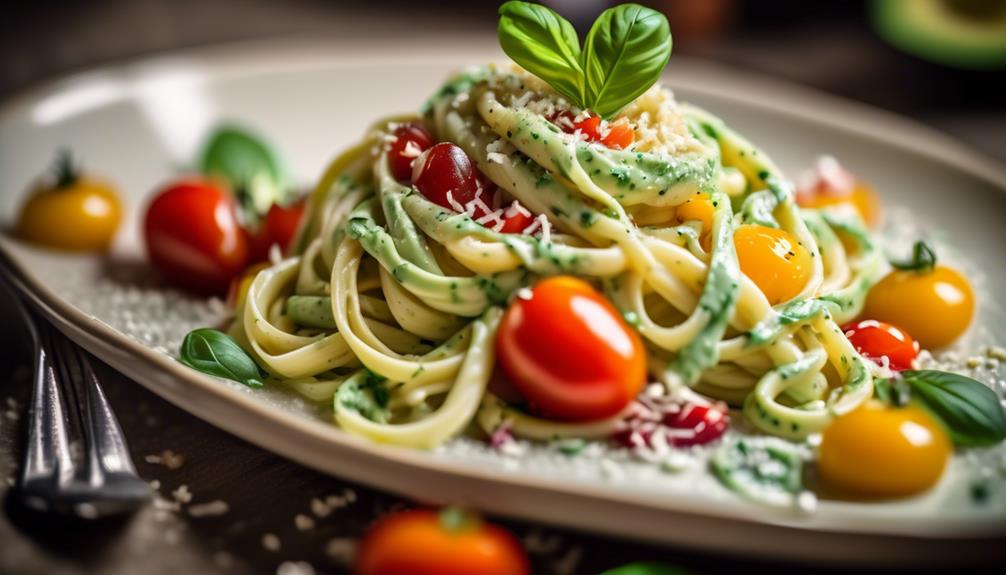
Hearts of Palm Linguini is a delicious and keto-friendly pasta substitute that offers a unique texture and taste to your vegetarian keto meals. Made from the tender inner core of the palm tree, hearts of palm linguini is a low-carb and low-calorie alternative to traditional pasta.
One of the major nutritional benefits of hearts of palm is its low carbohydrate content. With only 4 grams of carbs per serving, hearts of palm linguini is an excellent choice for those following a ketogenic diet. Additionally, hearts of palm is rich in fiber, which aids in digestion and helps you feel fuller for longer periods of time.
Another advantage of hearts of palm linguini is its low calorie count. With just 20 calories per serving, it allows you to enjoy a generous portion without worrying about exceeding your daily calorie limit. This makes it a great option for those looking to lose weight or maintain a healthy weight.
Hearts of palm linguini is also a good source of vitamins and minerals. It contains vitamin C, which supports immune function, as well as potassium, which helps regulate blood pressure. Furthermore, hearts of palm is a natural source of antioxidants, which can help protect your cells against damage caused by harmful free radicals.
Seaweed Pasta
Seaweed pasta is a nutrient-rich and keto-friendly alternative to traditional pasta, offering a unique flavor and texture to your vegetarian keto dishes. Made from seaweed, this pasta substitute is packed with numerous health benefits.
Here are some benefits of seaweed pasta:
- Rich in essential nutrients: Seaweed is a great source of vitamins A, C, E, and K, as well as minerals like iodine, iron, and calcium. Incorporating seaweed pasta into your diet can help ensure you're getting these important nutrients.
- Low in calories and carbohydrates: For those following a keto diet, seaweed pasta is a great option as it's low in calories and contains minimal carbohydrates. This makes it an ideal choice for those looking to reduce their carb intake.
- High in fiber: Seaweed pasta is high in dietary fiber, which can help promote digestive health, regulate blood sugar levels, and support weight loss efforts.
Now that you know the benefits, here are a few ways to cook seaweed pasta:
- Boil and drain: Cook the seaweed pasta in boiling salted water for a few minutes until al dente. Drain the pasta and use it as a base for your favorite sauces and toppings.
- Stir-fry: Heat some oil in a pan and stir-fry the seaweed pasta with vegetables, protein, and seasonings of your choice for a quick and flavorful meal.
- Cold salads: Toss cooked seaweed pasta with fresh vegetables, herbs, and a tangy dressing for a refreshing and nutritious salad option.
With its health benefits and versatility in cooking, seaweed pasta can be a delicious addition to your vegetarian keto repertoire.
Edamame Spaghetti
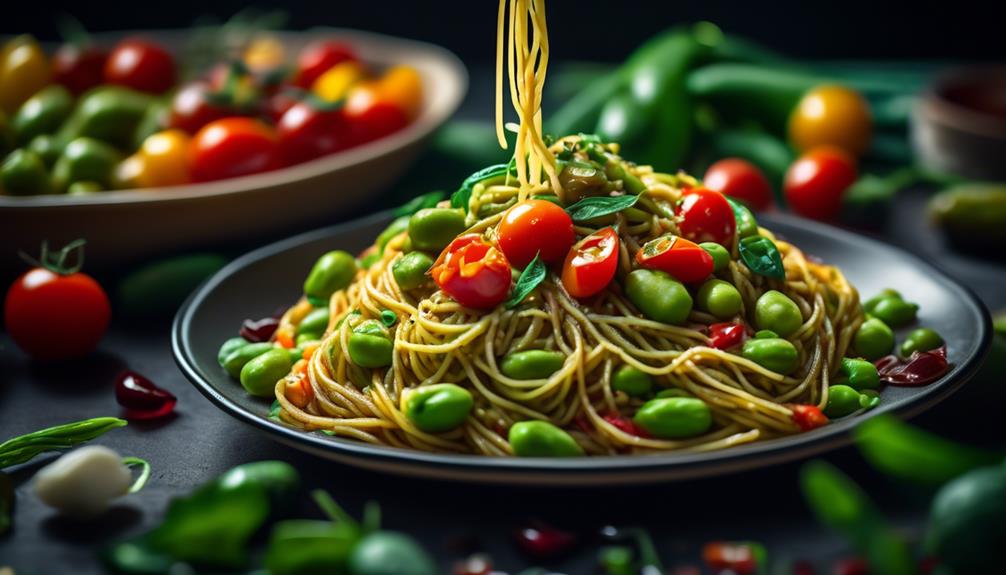
Edamame spaghetti is a nutritious and flavorful alternative to traditional pasta, perfect for those following a vegetarian keto diet. Made from edamame beans, this pasta substitute is low in carbs and high in protein, making it a great choice for those looking to reduce their carbohydrate intake while still satisfying their pasta cravings.
One of the main benefits of edamame spaghetti is its high protein content. Edamame beans are a complete source of protein, meaning they contain all the essential amino acids our bodies need for optimal health. This makes edamame spaghetti a great option for vegetarians and vegans who may struggle to get enough protein in their diets.
In addition to its protein content, edamame spaghetti is also rich in fiber, which can help promote feelings of fullness and aid in digestion. It's also a good source of vitamins and minerals, including folate, vitamin K, and manganese.
When it comes to preparing edamame spaghetti, there are countless delicious and creative recipes to try. You can toss it with your favorite low-carb sauce, such as a tomato and basil sauce or a creamy avocado sauce. You can also add it to stir-fries or salads for an extra boost of protein and fiber.
Tofu Shirataki Noodles
If you're looking for another satisfying pasta substitute on your vegetarian keto diet, consider trying Tofu Shirataki Noodles. These noodles are made from konjac flour, which comes from the root of the konjac plant. They're a low-carb and low-calorie option that can help you stay on track with your dietary goals.
Here are three reasons why you should give Tofu Shirataki Noodles a try:
- Low in carbohydrates: Tofu Shirataki Noodles contain very few carbohydrates, making them an excellent choice for those following a keto diet. They're made primarily of water and konjac flour, which means they're low in both carbs and calories.
- High in fiber: Konjac noodles are rich in soluble fiber, which can help regulate blood sugar levels and promote feelings of fullness. This can be especially beneficial for those looking to manage their weight or control their appetite.
- Versatile and easy to prepare: Tofu Shirataki Noodles can be used in a variety of dishes, from stir-fries to pasta salads. They've a slightly chewy texture and a neutral taste, making them a great base for your favorite sauces and toppings.
Incorporating Tofu Shirataki Noodles into your vegetarian keto diet can add variety to your meals while keeping your carb intake low. Give them a try and see how they can fit into your eating plan.
Kelp Noodles
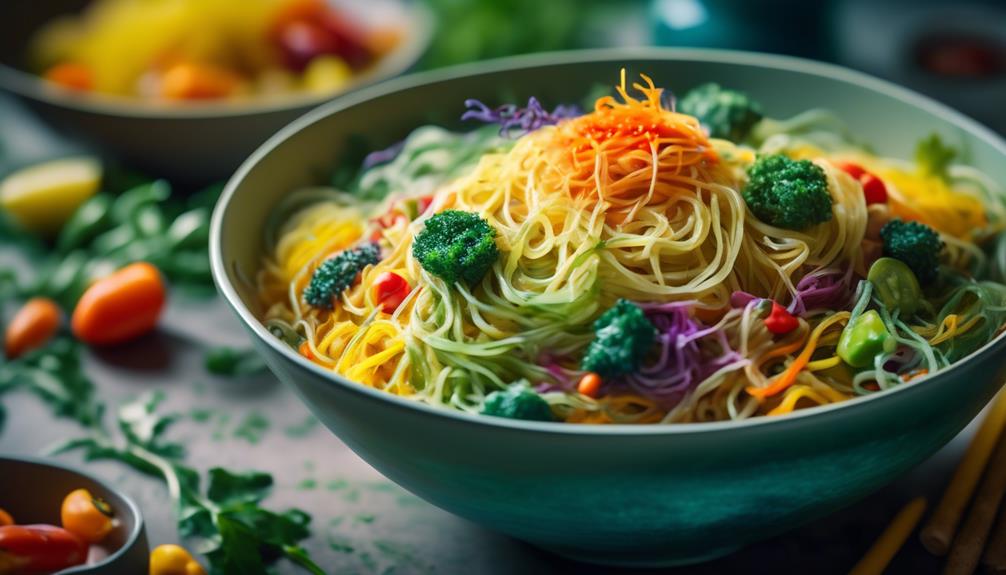
Kelp noodles are a nutritious and versatile option to consider when looking for a pasta substitute on your vegetarian keto diet. Made from the edible part of kelp seaweed, these noodles are low in carbs, making them a great choice for those following a keto lifestyle. One of the key benefits of kelp noodles is their incredibly low calorie content. With only about 6 calories per serving, they're an excellent choice for weight management.
In addition to being low in calories and carbs, kelp noodles offer several health benefits. They're a good source of iodine, a mineral that plays a crucial role in thyroid function and metabolism. Kelp noodles also contain a variety of vitamins and minerals, including calcium, iron, and magnesium, which are essential for overall health and wellbeing.
When it comes to preparing kelp noodles, there are numerous delicious recipes to try. You can use them as a base for salads, stir-fries, or even in soups. One popular recipe is kelp pasta with pesto sauce, where the noodles are tossed in a flavorful homemade pesto made from fresh basil, garlic, pine nuts, and olive oil. Another option is to sauté the noodles with vegetables and a dash of soy sauce or tamari for a quick and satisfying meal.
Jicama Slices
Jicama slices can be a satisfying and nutritious alternative to traditional pasta on your vegetarian keto diet. They're low in calories, high in fiber, and have a mild, crunchy texture that works well as a pasta substitute.
Here are three ways you can enjoy jicama slices in your keto recipes:
- Jicama noodle stir-fry: Replace traditional noodles with jicama slices in your favorite stir-fry recipe. The jicama noodles will soak up the flavors of the sauce and provide a refreshing crunch to the dish.
- Jicama pasta salad: Toss jicama slices with your choice of vegetables, herbs, and a keto-friendly dressing to create a delicious pasta salad. It's a great option for a light and refreshing lunch or side dish.
- Jicama lasagna: Layer jicama slices with your favorite keto-friendly ingredients like cheese, spinach, and tomato sauce to create a low-carb lasagna. It's a satisfying and flavorful alternative to traditional lasagna noodles.
To prepare jicama slices for your recipes, peel the jicama and cut it into thin, noodle-like strips using a mandoline slicer or spiralizer. You can eat jicama slices raw or lightly cook them for a softer texture. Experiment with different seasonings and sauces to find your favorite jicama pasta recipes.
Conclusion
In conclusion, there are numerous vegetarian keto pasta substitutes available that can satisfy your cravings while keeping you on track with your diet.
From zucchini noodles to spaghetti squash and shirataki noodles, these options offer a low-carb alternative to traditional pasta.
So, don't let your dietary restrictions hold you back from enjoying a delicious plate of pasta.
With these substitutes, you can have your 'noodle fix' without the guilt!


